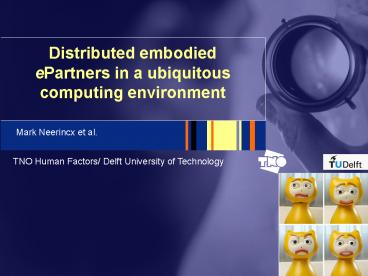Distributed embodied ePartners in a ubiquitous computing environment - PowerPoint PPT Presentation
Title:
Distributed embodied ePartners in a ubiquitous computing environment
Description:
Add a collection of distributed & connected personal electronic partners, ... assistance styles like 'motivational interviewing' and 'cooperative anamnesis' ... – PowerPoint PPT presentation
Number of Views:32
Avg rating:3.0/5.0
Title: Distributed embodied ePartners in a ubiquitous computing environment
1
Distributed embodied ePartners in a ubiquitous
computing environment
Mark Neerincx et al.
2
Introduction
- Environments with more networked information
compilations and technical equipment. - Add a collection of distributed connected
personal electronic partners, ePartners, to
support (distributed) human actors for specific
tasks, like - health-care actions by diabetics,
- technology use by elderly, and
- disclosure of feelings in high-demand missions
3
ePartner Human-Machine Collaboration
- Predicting the actors momentary needs
- on-line gathering and modeling of human, machine,
task and context information - Attuning the interaction to these needs
- (semi-)automatic tailoring of support, content
and dialogue to establish optimal human-machine
performance - Establishing natural H-M communication
- expressing and interpreting communicative acts
based on a common reference
4
Personal ePartner
- Sharing of experiences, learning and anticipation
- Common goal, but different roles and
responsibilities - Adequate distribution of workload
- Not copy of a human, but a complement
- Taking care of individual characteristics and
context of operation - Adequate level of trust and affection
- Quick understanding and natural communication
(one word is enough) - for specific goal and domain (e.g. self-care,
daily activities)
5
iCat as ePartner
- TNO and DUT use the iCat to develop
- models prototypes for effective social H-M
communication. - Research questions centre on
- the sensing and generation of affective
expressions (face, voice), - the application of different communication and
assistance styles like motivational
interviewing and cooperative anamnesis, - the effects of the embodiment of an ePartner
(e.g. compared to a virtual character).
6
The SuperAssist Project
Personal assistants supporting distributed
supervision of complex task environments. Each
human actor has an assistant for anomaly
detection, diagnosis and communication
7
Focus on Tele- and Self-Care
- More patients involvement in the care process
- Operating domestic medical instruments
- Management of a computer-based patient record
- Communication with medical technical
specialists - Increasing number of older people
- Chronic diseases 50 non-adherence
- Diabetes Type II
- Large, increasing group
- Typically older than 40
- Pancreas produces too little insulin
- Treatment involves diet, no-smoking, medication
exercising
8
Bottlenecks in Diabetes Care
- Shortage of diabetes nurses
- High No-Show in diabetes policlinic
- Lack of information during consultation
- Fixed consultation frequency (every 3 months)
- Lack of involvement/motivation of patients
- Too brief consult for adequate feedback to
patients - Large increase in patient numbers
9
Supporting the Patient
- Usage of medical equipment
- Human-assistant cooperation
- Health and lifestyle
- Therapy adherence
- Automation of assistance
- Human vs synthetic assistant
- Embodiment of the Assistant
- Social behavior
- Tests should show improvements for
- Patient behavior and opinion (e.g. trust)
- Adequacy and richness of dialogue
10
First iCat Experiment
- Goal
- Guidelines for adherence support
- iCat alternative for desk-top interface
- Background
- Health Buddy
- (Health Hero Network)
11
Guidelines
- Personal assistants
- Fun
- Trust
- Cooperation
- Psychology/ motivational interviewing
- Express empathy
- Communicate respect
- Listen rather than tell
- Social robots
- Express and perceive emotions
- Communicate with high-level dialogue
- Use natural cues (gaze, gestures, etc.)
12
Three User Interfaces
- Tiggie (Doellgroup)
iCat
Text (chat)
13
Pilot Test
- Social non-social iCat or Tiggie, vs
text-interface - 6 participants
- Scenarios
- 3 types (diet, self-check, medication), but
similar - Both open and closed questions
- 4 question blocks Monday, Wednesday, Friday and
Sunday - First results Social iCat preferred
- Trust
- Acceptance
- Empathy
- Personality
14
Conclusions
- Guidelines for Health Assistance
- Trust
- Fun
- Cooperation
- Express Empathy
- Communicate respect
- Listen rather than tell
- Future experiments
- Elderly
- Virtual iCat
- Personalization
- Dialogue management
- Long-term effects
- multi-Human multi-ePartner collaboration
15
Acknowledgement
- SuperAssist is partially funded by IOP-MMI Senter
a program of the Dutch Ministry of Economics - Three research institutes participate in the
SuperAssist project TNO, Delft University of
Technology (DUT), and Leiden University Medical
Center (LUMC) - Four companies are involved Philips Research,
Sigmax, Pemstar, Science Technology - Specific contributions to this presentation
- Rosemarijn Looije (RUG/TNO)
- Amy Ahluwalia (LUMC)
- Olivier Blanson Henkemans (DUT/TNO)
- Jasper Lindenberg (TNO)
- Lennard Kuijten (UM/TNO)
- Vanessa Sawirjo (DUT)
16
Questions?





























